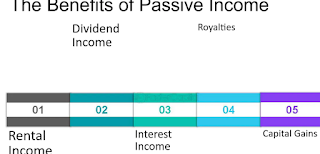Passive Income Benefits and How to Get Started Effectively
Most people seek some passive way of earning money without actually having to work for every dollar they earn. Passive income opens opportunities to earn money in a style that requires very little subsequent effort. These kinds of incomes free up time, whether for personal goals, hobbies, or family. The first step to financial independence is understanding the passive income basics.
If one thinks it is hard to start a passive income stream, this thought might be far from reality since it can be a lot easier than anticipated. Anything can start at any time due to the proper approach and tools that are needed. It could be done through investments, rental properties, or selling digital products. This article will take readers through the benefits of earning a passive income and how to go about doing it.
Key Takeaways
Passive income provides freedom over money and saves a lot of time.
There are several ways to create streams of passive income. It only takes some simple steps to get up and running with a plan that makes good sense. What is Passive Income? Passive income is money one receives without much effort from an initial setup. This concept provides financial stability and freedom, since one may then take other pursuits as needed in life.
What is Passive Income?
Passive income refers to earnings that are independent of active participation. Broken down more simply, this may be considered an investment return, rent, or business income without requiring direct activity for operation. Unlike working on a normal job where one stops earning an income the moment the work stops, passive income may persist even when someone is not working.
Most passive income ideas take time and energy to create upfront, yet pay off later. A very common example involves a rental property. There's work in the buying and managing of it, but once that's established, it can generate income with a much lower effort.
Types of Passive Income
There are a great number of types of passive income. Following are some of the most common types:
Rental Income: This is money one earns through rentals.
Dividend Stocks: The stocks of companies that pay dividends to shareholders for owning their stocks or shares. Peer-to-Peer Lending: This is where money is lent to individuals or businesses and interest earned via online platforms. Digital Products: Income from selling products, such as eBooks, online courses, and software. Each has different risks and rewards. For example, rental properties need ongoing maintenance; digital products are subject to marketing. It is thus necessary to select a type that best fits personal skills and interests.
The Role of Technology
Technology can play a big role in passive income. The Internet brings websites to help manage your investments, sell products, or find tenants. For example, property owners can advertise their rentals on websites and receive electronic payments; this comes in handy when renting properties out.
Software application is also usable to track investments and monitor streams of income. A number of people use applications with stock and even publish and sell any forms of digital content.
With technology, passive income is far easier to establish while freeing the time to better allow time management and the creation of revenue.
Getting Started with Passive Income
Passive income requires a lot of planning and consideration. It means developing an understanding of one's skill set and resources and laying a good foundation with that very first income stream. The following sections identify these important elements.
Assessing Your Skills and Resources
First of all, one should consider his skills and capital. The capital may be monetary investments or things one can do himself. He may ask himself the following questions:
- What am I good at?
- How much time can I invest?
- How much money can I invest?
One may keep in mind all the tools and platforms available for passive income creation. Take online courses or read books about it, or mentorships that may prove helpful.
Assessing these helps narrow the best passive income options. For example, an individual with special skills in writing can create a blog or even e-books.
Such an assessment lays a great foundation for further steps.
The Step-by-Step Guide on Your First Passive Income Stream
When the skill assessment is already done, the individual can now begin his first project. Below is a simple guide in doing so:
- Choose a Type: Go and choose any one passive income type-skill-oriented. It may be in the form of rental properties, affiliate marketing, or digital products.
- Research: Study the field under discussion. Understand market trends, competition, and perspective earnings.
- Create a Plan: Writing in detail the plan of execution is a must. This shall also include milestones and timelines.
- Launch: Start off small. Testing water gives valuable feedback.
- Promote: Extend it through social media/networks to larger audiences.
It helps in setting up the first stream of income efficiently.
Sustainability and Growth of Income Streams
Once an income stream has been established, the second part is its sustainability and scaling. The following are some of the strategies:
- Monitoring: Sources of income and performance measures are checked from time to time.
- Reinvestment: Earnings should be reinvested in upgrading or expanding the source of income.
- Keeping Knowledgeable: Keep looking for industry trends and adapt accordingly.
This can be improved by being consistent and adjusting to changes so that the income generated will increase. Consistency is the key to longer-term results.

